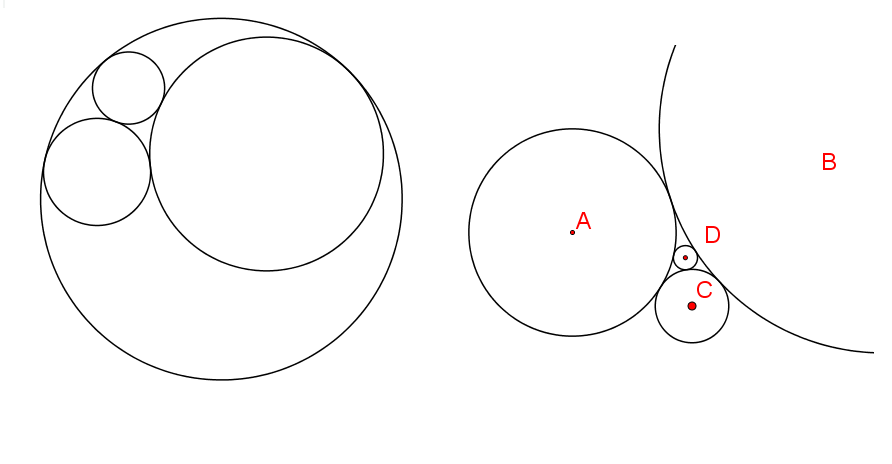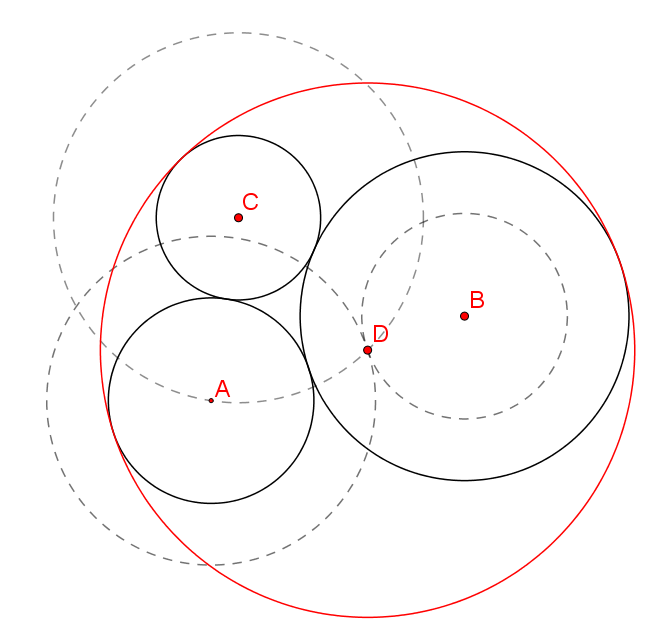Descartes Circle Theorem

Descartes arranged four mutually tangent circles as shown in figure 1. Even though it is possible to arrange the tangent circles such that they all share the same point, that is excluded from the Descartes arrangements. Descartes theorem is about finding the radii of the fourth tangent circle. How the circles are numbered is up to the user. Descartes defined a radial inverse as $k=1/r$. Therefore he used $k_{1},\;k_{2},\;k_{3},\;k_{4}$ and referred to it as the “bend” or “curvature” of the circles rather than using their radii. His formula is $$(k_{1}+k_{2}+k_{3}+k_{4})^{2}=2\left(k_{1}^{2}+k_{2}^{2}+k_{3}^{2}+k_{4}^{2}\right) \tag{1} \label{1}$$ If one of the circles encloses the other three, then that circle's bend is considered negative. Using the formula, one can find the radius of whichever circle is unknown by plugging in the bends for the other three. The formula solves for $k_{4}$ as below. $$k_{4}=k_{1}+k_{2}+k_{3}\pm2\sqrt{(k_{1}k_{2}+k_{2}k_{3}+k_{3}k_{1}}$$ As a rule, there will be 2 solutions, though not always. When there are two solutions, the positive one is the case where three circles surround a fourth. When negative, it is the case where a large circle encloses the other three.
The proof of Descartes theorem is done without calculus but is quite a bit of algebra. It can be found on the internet in many places. Often it is difficult to follow.
Once the radius of a fourth circle is known, it is easy to solve for the center point of a circle inside three others. Pick any two circles, for example the two with $r_{1}$ and $r_{2}$. About each center, construct a circle. For the first one, the radius will be $r_{1}+r_{4}$ and for the second one the radius will be $r_{2}+r_{4}$. The intersection of these two circles will be the center point of the circle with radius $r_{4}$.
In the case of a bounding circle, one must subtract the radius of a known circle from the newly found $r_{4}$. Do this twice with two known circles and construct circles with these new radii about the known centers. Their intersection will be the center of the bounding circle.

In the applet you might be able to grab $z_2$ or $z_3$ and move them around to see the consequence of making Descarte circles. When you form mututally tangent circles where it is not possible to have a bounding circle that is tangent to all three, then the fourth tangent circle will be external and curve away from the three circles rather than surround them. The smallest red circle can always be present and in the applet, it is the positive root in $k_4$.
Center of the Fourth Circle
The method that we have given thus far for finding the center of a Descartes circle requires a lot of algebra, since multiple circles have to be simultaneously solved. In 2001, Jeffrey C. Lagarias, Colin L. Mallows, and Allan R. Wilks (see arXiv:math/0101066 math.MG https://arxiv.org/pdf/math/0101066.pdf showed that the Descartes relation also holds for an equation involving the centers of the four circles when expressed in complex numbers. $$\left(k_{1}z_{1}+k_{2}z_{2}+k_{3}z_{3}+k_{4}z_{4}\right)^{2}=2\left(k_{1}^{2}z_{1}^{2}+k_{2}^{2}z_{2}^{2}+k_{3}^{2}z_{3}^{2}+k_{4}^{2}z_{4}^{2}\right) \tag{2} \label{2}$$ By itself, the equation doesn't simplify anything, but when used with $\eqref{1}$ we will have $k_{4}$ and can therefore solve $\eqref{2}$ for $z_{4}$ and have an algebraic expression for the fourth circle's center. $$z_{4}=\frac{z_{1}k_{1}+z_{2}k_{2}+z_{3}k_{3}\pm\sqrt{k_{1}k_{2}z_{1}z_{2}+k_{2}k_{3}z_{2}z_{3}+k_{1}k_{3}z_{1}z_{3}}}{k_{4}}$$ If we have any three circles that are mutually tangent, there will be exactly two other circles that can be tangent to all three. One of those new circles will be inside the middle where all three circles touch. The other one will either go around (bound) all three originals, or it will be external to all three originals and bend away.
There are two possible values for $k_{4}$ and two more for $z_{4}$. We can predict which $k_{4}$ goes with which $z_{4}$ with respect to the signs, but it makes a difference as to which quandrant the circles are in. The rules become tedious to write and I am not going to try.